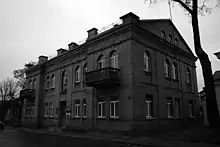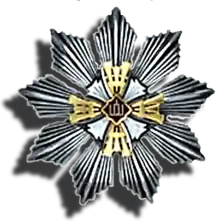Tadas Chodakauskas
Tadas Chodakauskas (May 4, 1889 – April 25, 1959) was the long-standing mayor of Panevėžys, Lithuania (1925–1940).
Tadas Chodakauskas | |
|---|---|
| Mayor of Panevėžys | |
| In office 1925–1940 | |
| Personal details | |
| Born | May 4, 1889 |
| Died | April 25, 1959 |
| Nationality | Lithuanian |
| Alma mater | St. Petersburg Imperial University and Pavel Military School |
| Military service | |
| Commands | Panevėžys County Military Commandant |
He was the brother of Romanas Chodakauskas (1883–1932), Sofija Smetonienė (1884–1968) and Jadvyga Tūbelienė (1891–1988). Tadas was a member of the Chodakowski noble family.
Early Life and Education
Tadas Chodakauskas was born May 4, 1889, at Gavėnonių Estate to Antanas Chodakauskas (1850–1925) and Maria-Joanna Chodakowska (1852–1910).[1]
He had one older brother, Romanas Chodakauskas (1883–1932) and two sisters, Sofija Smetonienė (1884–1968) and Jadvyga Tūbelienė (1891–1988).[1]
He studied at St. Catherine gymnasium in St. Petersburg, graduating in 1907, and then at St. Petersburg Imperial University.
Russian Imperial Army
On November 1, 1914, Tadas was conscripted into the Russian Imperial Army and assigned to the Grodno Life Guards Hussar Regiment, a light cavalry regiment.[2]
After conscription, he studied at the Pavel Military School in St. Petersburg.[2][3]
By 1917 he was serving as the Commander of the 171 Battalion Company.
Lithuanian Volunteer Army
In 1918 Tadas returned to Lithuania and settled in Panevėžys.
On December 8, 1918, he joined the Lithuanian volunteer army.
On May 26, 1919 he was appointed an Officer for Special Affairs at the headquarters of the Ministry of National Defence, and a week later he became a member of Panevėžys and county military commandant, serving from 1919 to 1924.
On June 1, 1920 Tadas was promoted to the rank of Captain and then on October 11, 1920 he graduated from the upper courses for officers.
On June 1, 1923 Tadas was promoted to the rank of Major and then, on January 23, 1924 he was appointed head of mobilization for the Panevėžys district.
On February 10, 1925 he was released from the army.
Mayor of Panevėžys (1925-1940)
In 1925 Tadas was elected Mayor of Panevėžys, a post he would hold until 1940.[3]
While mayor he lived at 22 Vasario 16-Osios gatvė, Panevėžys and bought Staniūnai Manor, a property on the outskirts of Panevėžys.
During this time he was also a member of the Board of the Panevėžys Branch of the State Bank of Lithuania.[4]
On January 22, 1928, Tadas was elected the chairman for the second board of the Panevėžys branch of the LKKSS. He held the position until 1936[5] In 1929, Tadas built a villa in Berčiūnai, which was an alternative to Palanga for holidaymakers.[6] The resort near Panevėžys was loved by students, intellectuals and the nobility. Writer, public figure and Tadas' cousin Gabrielė Petkevičaitė-Bitė, 1936–1938, spent summers in Berčiūnai.[7]
Soviet Occupation
After the Soviet occupation of Lithuania in 1940, Tadas and his family drove from Panevėžys to the Masurian Lakes in Poland to join his sisters Sofija and Jadvyga and Antanas Smetona.[8]
In his “Pro memoria”, Antanas Smetona described what Tadas told them:
“He told us a lot of news from the border. All of it was sad: some people have been arrested in Lithuania, others are in prison... On both sides of the border, there is talk that the Germans will be back soon and they will chase the Bolsheviks from Lithuania. So he hopes to return home in August."[9]

Tadas and his family stayed with the Smetonas at the Hunters' Heights (Gästeheim Jägerhöhe) at the Schwenzait resort in the Masurian Lake District. The resort was located about four km from the city of Angerburg (Węgorzewo).
When Antanas Smetona, Sofija and Jadvyga left for Berlin on August 17, Tadas and his family went to Danzig (now Gdańsk).[10]
There Tadas got a job as a manager of the German state farm Lebabrik.
His wife, Jadvyga, and son Stanislavas were interred in a German refugee camp.[10]
As the Red Army approached, Jadvyga and Stanislavas managed to move west, while Tadas remained in the city. Jadvyga and Stanislavas eventually emigrated to the United States.
Tadas, however, was considered missing.[11][12] In June 1940, the Lithuanian Saugumas, the state security service now in the hands of the pro-Soviet regime, reported that people in the Panevėžys region of Lithuania welcomed the “fall of the Chodakauskas dynasty” that had so dominated local politics.[13]
Return to Lithuania
Tadas had obeyed a strict requirement of the Germans and fell into the Soviet-occupied part of Germany.
After receiving fictitious documents in the name of Leonas Liutkevičius, he returned to Lithuania, settled in Čyčkai village, Vilkaviškis district and got a job as an auxiliary worker with a farmer named Masaitis.[10]
The priest of Lankeliškiai parish, Justinas Lelešius (partisan name ‘Grafas’)[14] (1917-1947) (the most famous of the few priests who took an active part in the fight against the Soviet occupiers and is probably the only partisan chaplain who fought in the ranks of partisans)[15] asked Tadas to join the resistance movement.[10]
NKGB Agent
On December 22, 1945 the NKGB (the Soviet state security apparatus from 1943 to 1946) arrested, interrogated and broke Tadas.[16]
He became a NKGB agent (code name ‘The Lion',[16] personal file number: 15136.) He was originally used as a prison cell agent in Marijampolė Prison.[16]
On May 1, 1949 he participated in the famous MGB (the Soviet state security apparatus from 1946 to 1953) operation at Palanga.[17][18]

Undercover officers sent by the British Secret Intelligence Service (aka MI6) and led by Jonas Deksnys, landed at Palanga at two a.m. to assist with the anti-Soviet resistance. They included Deksnys, his wireless radio operator, Justas Briedis, Kazimieras Piplys, a Latvian named Vidvuds Sveics and two Estonians. Tadas was introduced to them as the Commander of Samogitian District and lured them into a trap.[16]
Deksnys, Sveics and Piplys managed to escape but the two Estonians and Bredis died in the shooting.
This operation had a decisive influence on the destruction of the Bendras Demokratinio Pasipriešinimo Sąjūdis (BDPS) (en: ‘General Movement for Democratic Resistance’), which was trying to unite all anti-Soviet resistance forces in the Baltic states.
Jonas Deksnys was later captured by the MGB and became ‘agent Petrenko’. The MGB used him to spread disinformation abroad via ‘radio games’ and for propaganda purposes within Lithuania via the press and cinema.[19]
Death and Burial
On April 22, 1959 Tadas died in Vilnius[3] from a heart attack.
He was buried at Saulės Cemetery, Vilnius, on April 25, 1959.
Awards and Collections
Tadas was awarded the Cross of Vytis, 5th Degree Order (in 1929) and The Order of the Lithuanian Grand Duke Gediminas, 3rd class order.[3]
Some of Tadas’ furniture is displayed at Panevėžis Museum and a section of the exhibit is devoted to him.
Tadas was an antiquarian and collector of objets d'arts. One of his relatives has an 18th-century pocket watch made by Tobias in London, which has a jewelled and enamelled Russian case. He was told it originally came from Tadas.
Personal life
Tadas married Jadvyga Kosinskaitė-Velti (1899-1974) on February 15, 1922, in the Kėdainiai district municipality.
She had one son, Stanislavas (1920-c1975), from a previous marriage. In 1929 Tadas officially adopted Stanislavas.
Jadvyga Kosinskaitė-Velti and Stanislavas emigrated to the USA where their descendants still live.
References
- Jakubavičienė, Ingrida (2020). Portretas. Vilnius: Tyto alba. p. 54.
- Lietuvos Kariuomenes Karininkai 1918–1953. Vilnius: Lietuvos nacionalinio muziejaus biblioteka. 2003.
- "PANEVĖŽIO JUBILIEJINIŲ DATŲ KALENDORIAI".
- Jakubavičienė, Ingrida (2015). Duetas. Vilnius: Versus Aureus. p. 89.
- "Lietuvos kariuomenės kūrėjų savanorių sąjungos Panevėžio skyriusnuotraukos".
- "Lietuvos miestų ir miestelių modernizacija: Panevėžys".
- "PAIEŠKOS REZULTATAI PAGAL UŽKLAUSĄ: ŠILGALYT".
- Jakubavičienė, Ingrida (2020). Portretas. Vilnius: Tyto alba. p. 336.
- Smetona A., Nuo Mozūrų ežerų ligi Šveicarijos, l. 11, mašinraščio kopija, saugoma Istorinėje Lietuvos Respublikos Prezidentūroje.
- Jakubavičienė, Ingrida (2020). Portretas. Vilnius: Tyto alba. p. 375.
- Jakubavičienė, Ingrida (2014). Seserys. Vilnius: Versus aureus. p. 199.
- 1945 11 15 S. Smetonienės laiškas Lietuvos konsului Čikagoje P. Daužvardžiui, VDU LII, f. 1, ap. 1–3, b. 3994-90, l. 1.
- Senn, Alfred Erich. (2007). Lithuania 1940: Revolution from Above. New York: Rodopi. p. 31
- Vytautas Lelešius. Justinas Lelešius. Visuotinė lietuvių enciklopedija, T. XI (Kremacija-Lenzo taisyklė). – Vilnius: Mokslo ir enciklopedijų leidybos institutas, 2007. 711 psl.
- "XXI amžius". www.xxiamzius.lt. Retrieved 2020-11-18.
- Jakubavičienė, Ingrida (2020). Portretas. Vilnius: Versus Aureus. p. 376.
- "Žvalgybiniai desantai ir rezistencija".
- "KGB agentūros archyvinių asmens bylų registracijos žurnalas".
- Bower, Tom (1993). The Red Web. London: Mandarin Paperbacks.
